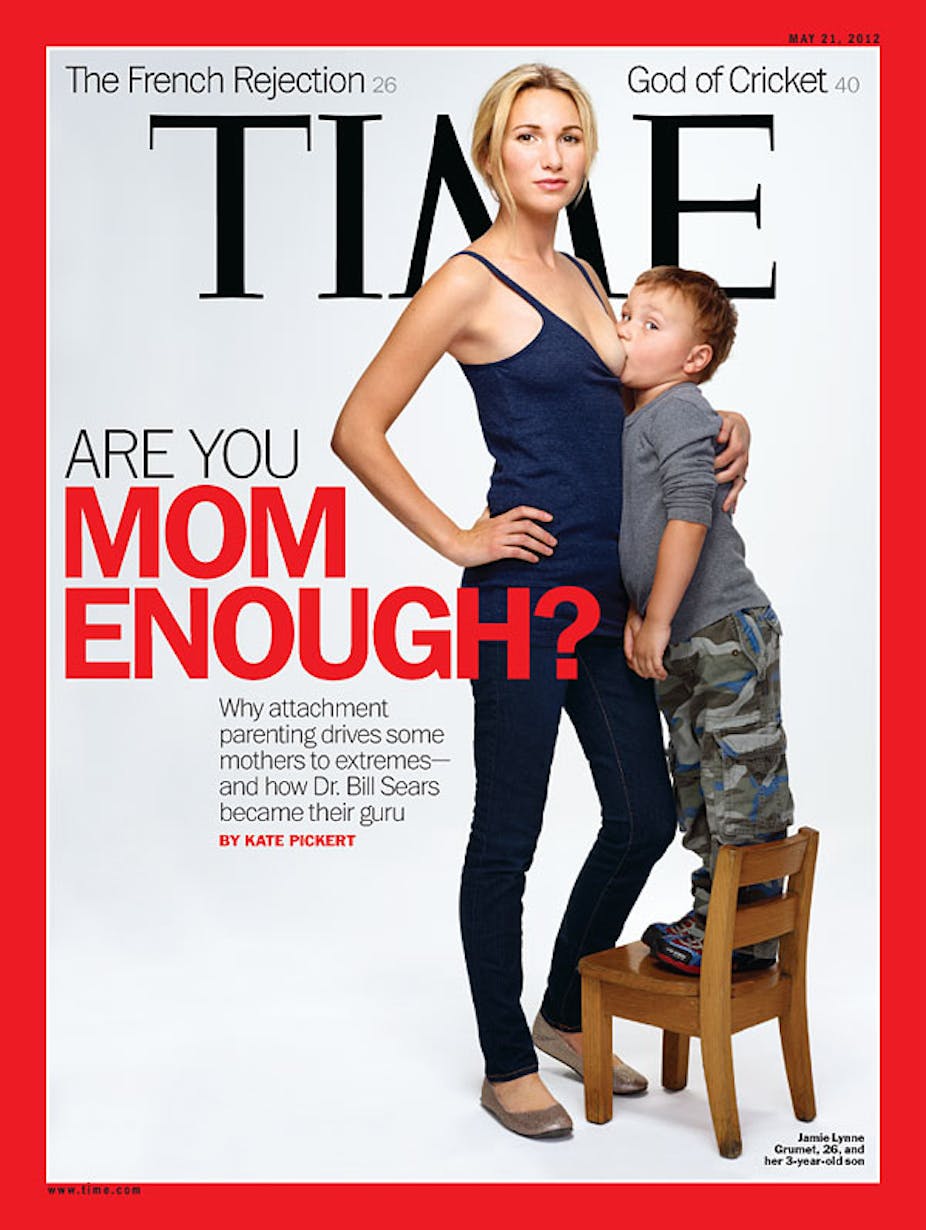The media storm surrounding Time magazine’s recent cover featuring a three-year-old boy breastfeeding while standing on a chair, indicates how important it is for more images of breastfeeding to be circulated in the media – and for more of these images to be striking and diverse.
Editor Richard Stengel was frank in admitting he chose the image knowing it was provocative. Nevertheless, there’s a reasonable defence to be made of the photograph, based on its relevance to the cover story about attachment parenting. Attachment parenting promotes extended breastfeeding, co-sleeping and maximising skin-to-skin contact.
More importantly, there’s a defence to be made on the grounds that there are simply too few images of mothers breastfeeding their babies, and this contributes to women’s reluctance or inability to breastfeed their children beyond a certain age. Although an impressive 96% of Australian mothers initiate breastfeeding, indicating their strong desire to do so, by six months of age the figure has fallen to just over 50% and by two years, 5%.
This is despite the World Health Organisation’s (WHO) recommendation that we breastfeed exclusively to six months and continue mixed feeding for “up to two years … or beyond”.
A 2004 “overview of recent reviews” by NSW Health noted that there were “few descriptions of advocacy strategies to promote the acceptability and image of breastfeeding.”
Drawing from a report in 2002, it concluded that breastfeeding “could be more actively supported and promoted by publishing more newspaper articles that present a positive message … more positive headlines, and more breastfeeding photos.”
Most importantly, it stated that only “1.3% of 334 articles were accompanied by a baby being breastfed.’
The circulation of images and media coverage via social and online media, of breastfeeding celebrities such as Miranda Kerr, Toni Collette and Salma Hayek, has since enhanced the accessibility of images to some extent. But the fact that these images invariably attract controversy indicates there’s plenty of room for improvement.
Facebook, which has removed personal breastfeeding images posted by users, continues to do so over uncertainty about their decency, and confusion about the ethics of a mother visually documenting her breastfeeding relationship and sharing it with her friends.
One of the most important cultural reasons that women don’t breastfeed for longer, is that there are so few images of women breastfeeding, so few opportunities for people to observe breastfeeding women, to learn about breastfeeding through incidental exposure, and to consider it commonplace.
The rare sight of a mother breastfeeding in public is often fraught with anxiety from passers-by, who don’t know where to look, and mothers, who are uncertain of their rights.
While the medical research around the benefits of breast milk has been useful in promoting breastfeeding since it hit rock bottom in the 1970s, an unintended side effect of the scientific discourse has been to make breastfeeding "special” and breast milk “liquid gold”.
This has created both a tone of high seriousness around breastfeeding, which must be engaged in for nutritional and health reasons, and a scarcity model, with new mothers feeling they have to learn the “right way”, eat the “right food” and read the “right books”, to be successful.
While helpful to lactation consultants as well as mothers starting out, this way of thinking about breastfeeding overlooks the simple fact that women’s bodies make milk, and babies drink it most easily from their breasts.
The scientific approach has also allowed us to forget that breastfeeding is pleasurable for mothers when it’s adequately supported, and that, like most forms of eating, children breastfeed for enjoyment and comfort as well as hunger.
Even images used to promote breastfeeding have tended to rely on Madonna-and-child iconography that’s dutiful and virtuous, with a mother and infant whose gaze is modestly averted. These images are not only unnecessarily serious, they fail to revel in the fact that breastfeeding engages our breasts.
A recent US campaign promoting breastfeeding relied on visual puns, such as two stethoscopes, ice cream scoops, or flowers because of a reluctance to show the feeding breast, even by those who most support it.
Australian breastfeeding scholar Karleen Gribble concludes her 2005 study of the motivations of children who breastfeed for longer saying, “The most common reason for a mother to breastfeed her baby beyond two years was the child’s own enjoyment.”
Adding, only “7% of women said they had intended to breastfeed this long [but] for these mothers, there was a change in their own attitude, usually as a result of seeing others breastfeed toddlers, or their increasing knowledge and confidence, or their own enjoyment of breastfeeding.”
Time is to be congratulated for providing us with this image, which not only shows that breastfeeding might extend beyond infancy, but that it can also be funny and fun. Perhaps if we begin to acknowledge its pleasures as well as its virtues, our breastfeeding rates might increase.
Read more stories on Time’s controversial cover:
Time #1: What’s wrong with this picture?
Time #2: Extreme parenting, Time magazine style
What do you think of the image and the article? Leave your comments below

